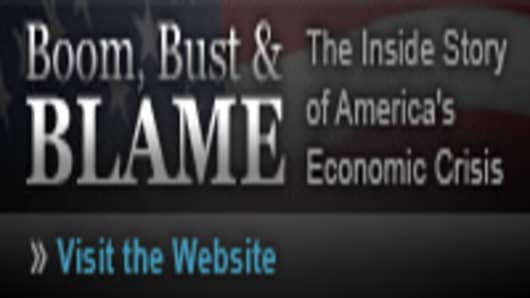The output gap is a measure of how far away an economy is from a targeted level of output. But does it matter?
The concept of an output gap forms a key part of the argument put forth by “saltwater” economists like Paul Krugman that the government should be doing more through monetary and fiscal policy to stimulate economic growth. The idea is that the economy is so badly under-performing that it requires government action to get it back up to target levels.
Here’s a version of the chart that Krugman and crew often use to illustrate the output gap. It shows the difference between the economic output we would have if the economy grew at a steady rate according to its long term trends and our actual economic output.
Notice, however, that the output gap is not anything that actually exists in the real world. It is a purely theoretical construct. It is measuring the actual economy against a counter-factual economy, reality against a model.
And the model is a very strange one because it sees growth as proceeding in a straight line, when actual economic growth is always full of bumps and ruts, and sometimes climbs hills and plummets into deep valleys.
If this were a purely theoretical concept that would be fine, but these Output Gappers want it to translate into real world policy. If the output gap is large, that means we shouldn’t worry about inflation and should pump in more economic stimulus. After all, look at the productive capacity that is sitting idle. Close the gap!
To see why this leap from theory to policy is a mistake, let’s do a little thought experiment I’ll call “Tobacco America.” Imagine that the United States had never participated in the industrial revolution and instead remained a largely agrarian society. Now imagine that, following the abolition of slavery, we had to turn away from cotton production in much of the country toward the production of tobacco.
Eventually, a huge part of the economy came to be based on the production of tobacco and the processing of the crop into various consumer products.
After several decades of growth punctuated by mild recessions, tobacco booms. The price of land and seed explodes. People are smoking everywhere. Every workplace is like a scene from the TV show "Mad Men".
Then everything changes. The cancer-causing and addictive aspects of tobacco become widely known. Taxes on tobacco are raised around the world. Smoking bans are put in place. Global demand for tobacco plummets.
The economy slumps. The output gap — the actual economic output measured against the historical trend line — widens out. Unemployment explodes and then remains stubbornly high.
It’s not just the old tobacco hands that are unemployed — so are those who sold things to the tobacco farmers, and the people who sold things to them, and the people who made the things they sold, and the people who transported those products, and the people who made the trucks that transported the products, and so on.
The government responds to the situation with stimulus spending and targeted tax cuts. The Federal Reserve slashes interest rates and engages in creative credit easing.
But the output gap persists, leading Paul Krugman to call for more stimulus and a more aggressive monetary policy. We shouldn’t be worried about inflation, Krugman argues, we should be worried about the output gap.
But the output gap here is caused, largely, by the dramatic decline of the tobacco industry. There are fields that have never been used for anything but tobacco. Many farmers do not know much about growing other crops, at least not at an economically competitive scale. The machinery on the farms and in the tobacco processing plants is specialized and not good for much else.
What’s more, the farmers are deeply in debt. They had borrowed to finance additional purchases of tobacco seed — the cost of which had skyrocketed during the boom. Now their seed is worth a fraction of the original cost, far less than what they owe the banks. Some of them are thinking about just dropping seed off at the bank to repay their loans.
What we see here is that the economy is not “underperforming” in any real way. It is performing at the level appropriate to the resources it has. It’s just that now that the tobacco boom is over, it’s clear that many of our resources are no longer as productive as they once were. Fields that were awesome at growing tobacco might not be as good for other crops. There’s an excess supply of workers with tobacco related skills. Machinery for making cigarettes is probably worth more as scrap metal.
The output gap would just measure the difference between reality and what the economy could do if demand for tobacco hadn’t suddenly declined.
Back in our world, this same thing is true. Our output gap is not a measure of economic underperformance or “lost output.” We might not be underperforming at all. We’re very likely performing at exactly the capacity appropriate for a people with the combination of assets, liabilities and skills we actually have.
What the Output Gappers miss is that a lot of the productive capacity built during a boom —whether that’s machinery, skills, business relationships, or financial products — might not be very useful when the bust comes around. Having the government spend more or pump out more dollars won’t somehow reverse this process.
Stimulus spending and monetary easing won’t overcome an output gap if it is caused by an actual reduction in the productive capacity of the country. And a shift in demand away from what we’re equipped and skilled at making is the equivalent of a reduction in productive capacity. We have relatively less capacity to make what’s actually in demand because so much of our capacity is dedicated to making what’s fallen out of favor.
It’s easy to see this is the case in Tobacco America. Is it true in our America?
Look at the latest housing starts numbers. In April, housing starts came in at an annual rate of just under 523,000 per year. Back in 2007, the April rate was over 1.5 million annually. That means that we now have around one-third of the demand for the house building skills, equipment and financing that we once did. Two-thirds of it is the equivalent of tobacco in our thought experiment.
__________________________________________
Questions? Comments? Email us atNetNet@cnbc.com
Follow John on Twitter @ twitter.com/Carney
Follow NetNet on Twitter @ twitter.com/CNBCnetnet
Facebook us @ www.facebook.com/NetNetCNBC




